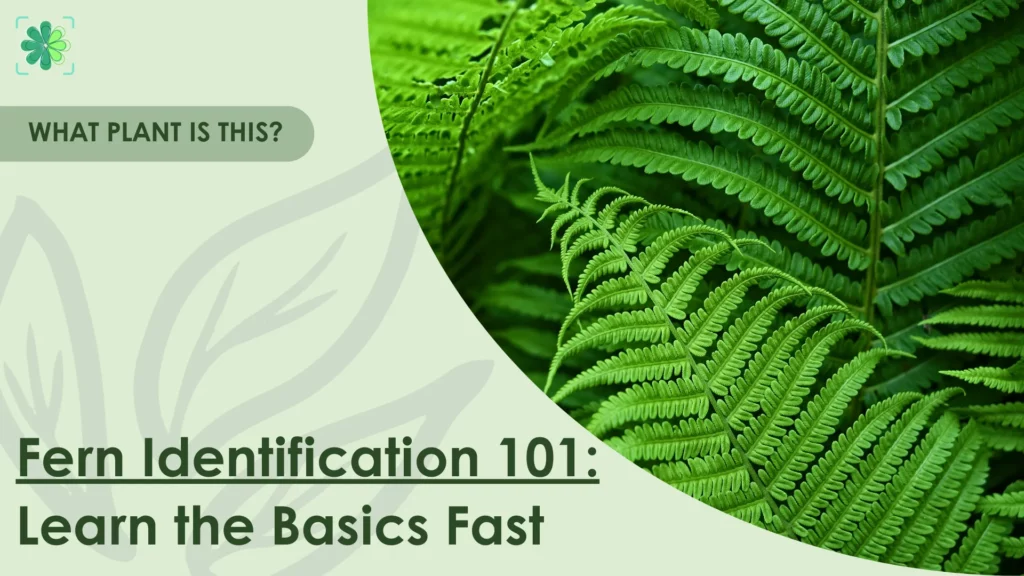
Ferns are some of the oldest plants on Earth. With no flowers or seeds, they reproduce through spores and come in a wide range of shapes and sizes. There are over 15,000 known fern species globally, and while they’re common, telling them apart isn’t always easy.
This fern identification guide is for anyone who’s ever crouched down beside a leafy frond and wondered, “Which one is this?” Whether you’re a hiker, gardener, student, or nature lover, this guide will help you see ferns with new eyes and recognize the subtle traits that separate one species from another.
Why Fern Identification Matters?
Actually, being able to identify ferns opens up a lot more than you might expect. Ferns often give you subtle clues about the health of an ecosystem, the history of a landscape, or even whether a spot has hidden water nearby. Here’s why fern identification really matters:
- Ferns help you read the environment, revealing clues about soil, moisture, and sunlight levels.
- Certain ferns grow only in untouched habitats, making them signs of rare or sensitive ecosystems.
- Some species hint at past human activity, like land clearing or old trail systems.
- It prevents mix-ups when foraging or gardening. Some fiddleheads are safe, others are not.
- Native fern ID supports better choices in landscaping and ecological restoration.
- Learning to recognize ferns sharpens your observational skills and deepens your appreciation for nature walks.
Key Features to Examine When Identifying Ferns
If you want to get good at identifying ferns, the key is learning to slow down and really look. Ferns don’t shout their names with bright flowers or bold scents. They whisper through shape, texture, and structure. Here are the six traits you should always check when trying to figure out what species you’re looking at:
Frond Structure
Start by looking at the whole frond; the leaf of the fern. Is it one smooth shape, or is it divided into smaller parts? Most ferns have divided fronds, but how they’re divided makes a big difference.
Some are once-divided, meaning each leaflet (called a pinna) comes straight off the main stem (the rachis). Others are twice- or even thrice-divided, with each leaflet split into smaller pieces (called pinnules). The more finely divided the frond, the more delicate or “lacy” it tends to look. This is often the first thing you should notice, especially when comparing species like the marginal wood fern (twice-divided) versus something finer like a lady fern (thrice-divided).
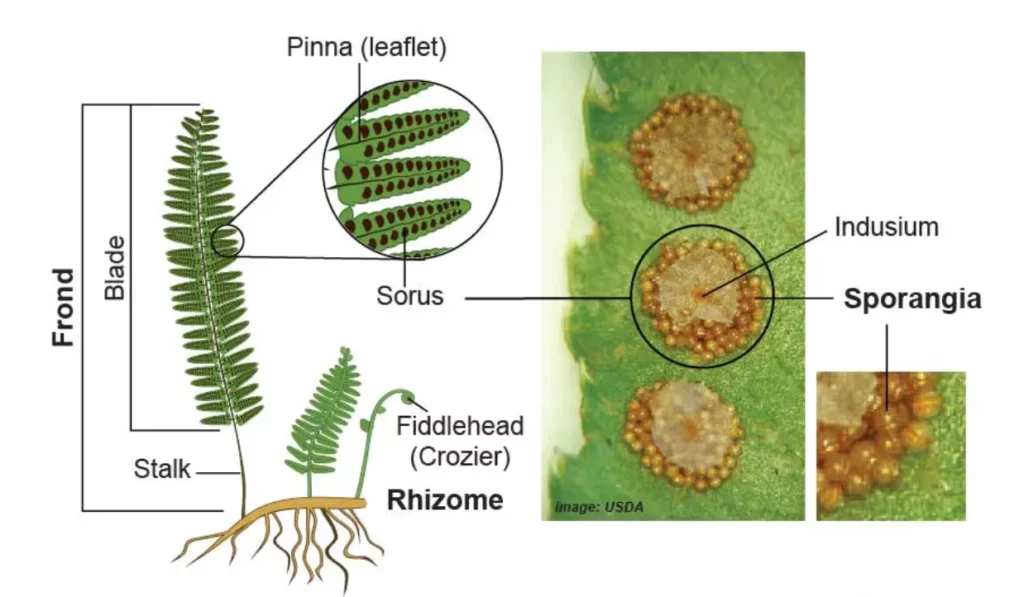
Leaf Shape
Next, pay attention to the overall shape of the blade. Some ferns have broad, triangular fronds that taper to a point. Others are long and narrow like a feather. Some, like the New York fern, taper at both ends: thin at the base and tip, widest in the middle. That detail alone can help you ID it quickly in the field. The shape often connects to how the fern grows and what kind of light it prefers, so it’s not just a visual clue. It tells you a bit about the plant’s lifestyle, too.
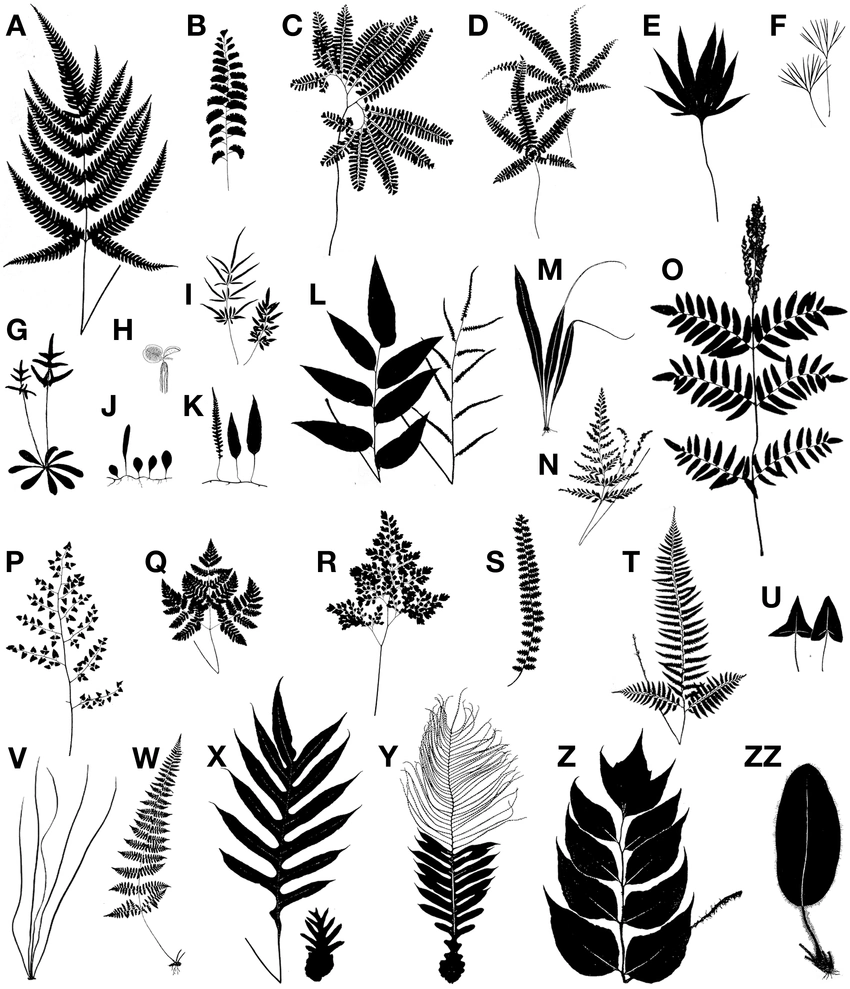
Venation Pattern
Flip the frond over and take a look at the veins. This part is subtle, but powerful once you know what to look for. Some ferns have netted venation, where the veins create a fine mesh, like in the sensitive fern. Others have free venation, where the veins run more or less straight out from the midrib to the edge, like in wood ferns.
You may need a magnifying lens for this, but if you’re using a photo ID app like Planteyes, snapping a clear photo of the underside will help the system pick this up automatically.
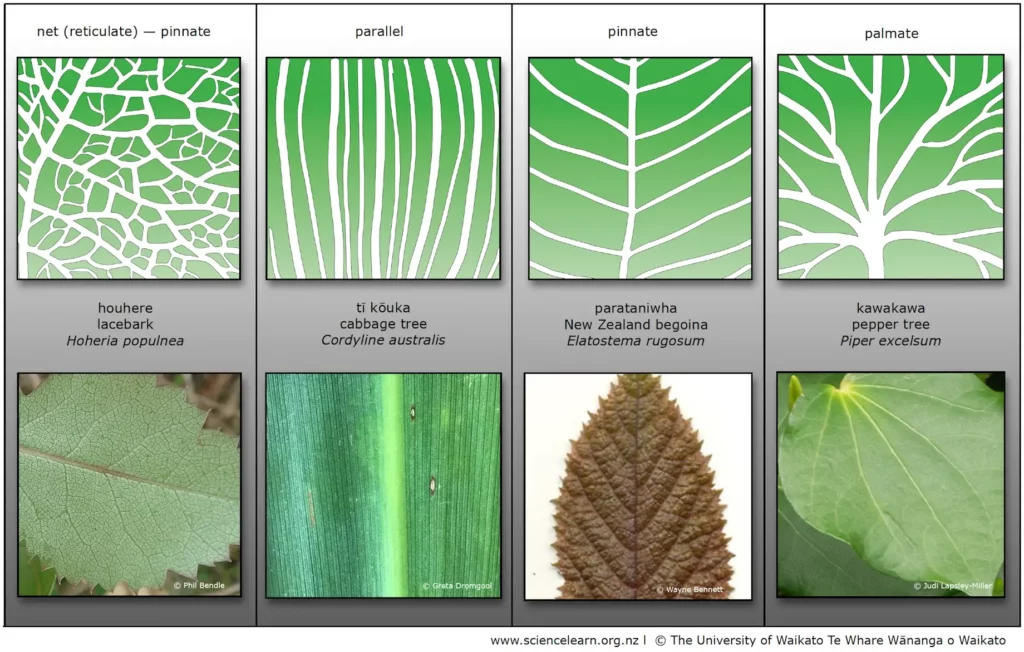
Sori Pattern
Sori (pronounced sore-eye) are tiny clusters of spore cases, usually found on the underside of the frond. They resemble small dots or bumps and come in various patterns, depending on the species. Some are lined neatly along the edge (as in marginal wood fern), others form bead-like rows (like sensitive fern), and some are grouped in the middle of the blade (like interrupted fern, which is actually “interrupted” by its sori). This is one of the most reliable features to use for identification, especially during the growing season when the sori are mature and visible.
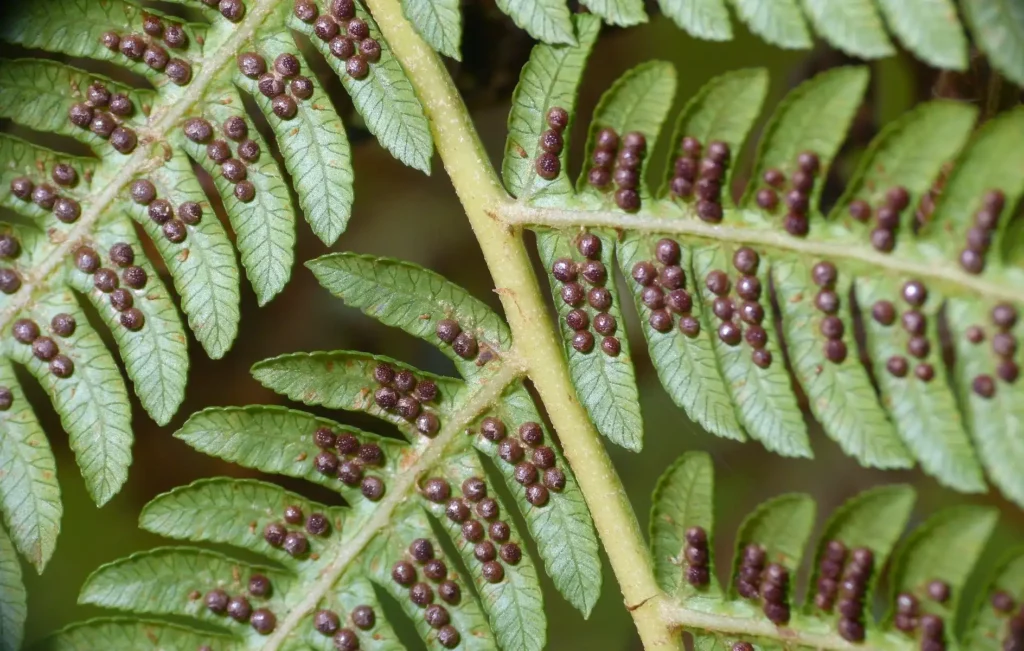
Growth Habit
Finally, step back and look at how the fern is growing. Is it forming a tight, upright clump? Is it spreading along the ground, sending runners out from the base? Is it growing alone or in a colony?
For example, ostrich ferns form neat, symmetrical vase-like clumps, while New York ferns grow in dense colonies that can spread across forest floors. And if you find a lone fern growing from a rock wall, chances are you’re looking at something like the marginal wood fern, which loves rocky environments. Observing the habit of the plant — its posture, how it holds space — gives you a macro clue to go with the micro details.
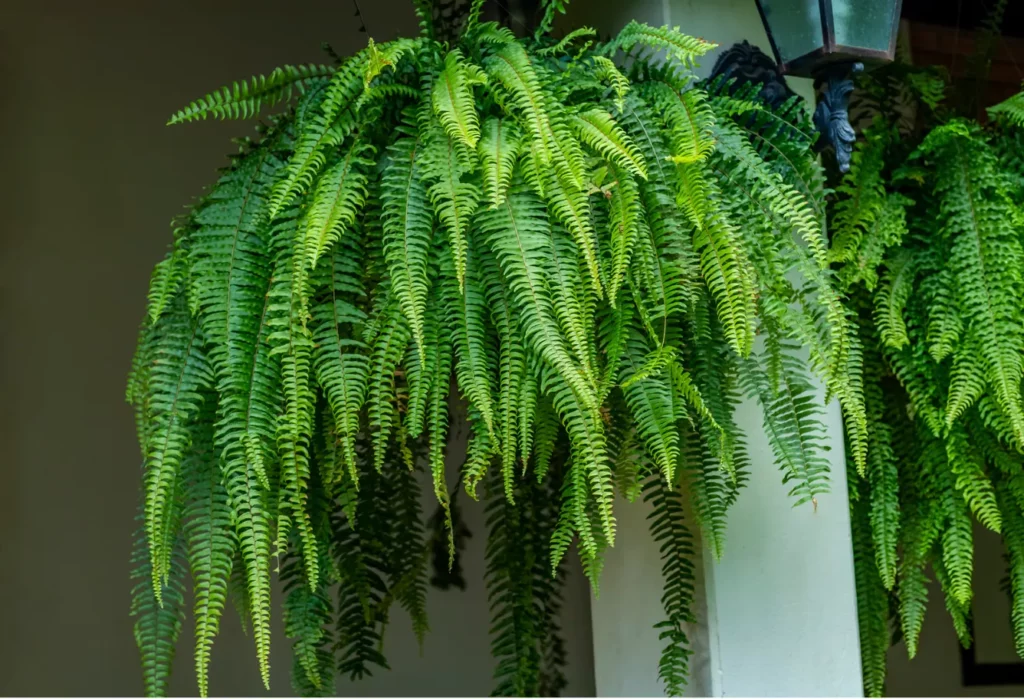
Fern Identification Chart
Here’s a quick visual reference that highlights a few key species and compares them.
| Fern Type | Frond Shape | Sori Pattern | Common Location |
| 1. Male Fern | Long, divided | On underside of leaflets | Woodlands |
| 2. Ostrich Fern | Vase-like | Only on central fertile fronds | Wet, shady areas |
| 3. Christmas Fern | Lance-shaped | Under each leaflet | Shady slopes and woodlands |
| 4. Sensitive Fern | Broad, tapering | Bead-like, upright fertile fronds | Wetlands, ditches |
| 5. Marginal Wood Fern | Tapered, leathery | Along margins of leaflet | Rocky woods, stone walls |
| 6. Interrupted Fern | Twice-cut | Fertile middle portion only | Woods, roadsides |
| 7. New York Fern | Tapers top and bottom | Scattered under fronds | Sunny woodland edges |
Common Fern Species and How to Recognize Them
Once you’ve learned the basic features of ferns, the next step is putting that knowledge into practice. In this section, we’ll walk through some of the most recognizable fern species, explaining how they grow, what sets them apart, and what details to focus on when you find them in the wild.
Interrupted Fern (Osmunda claytoniana)
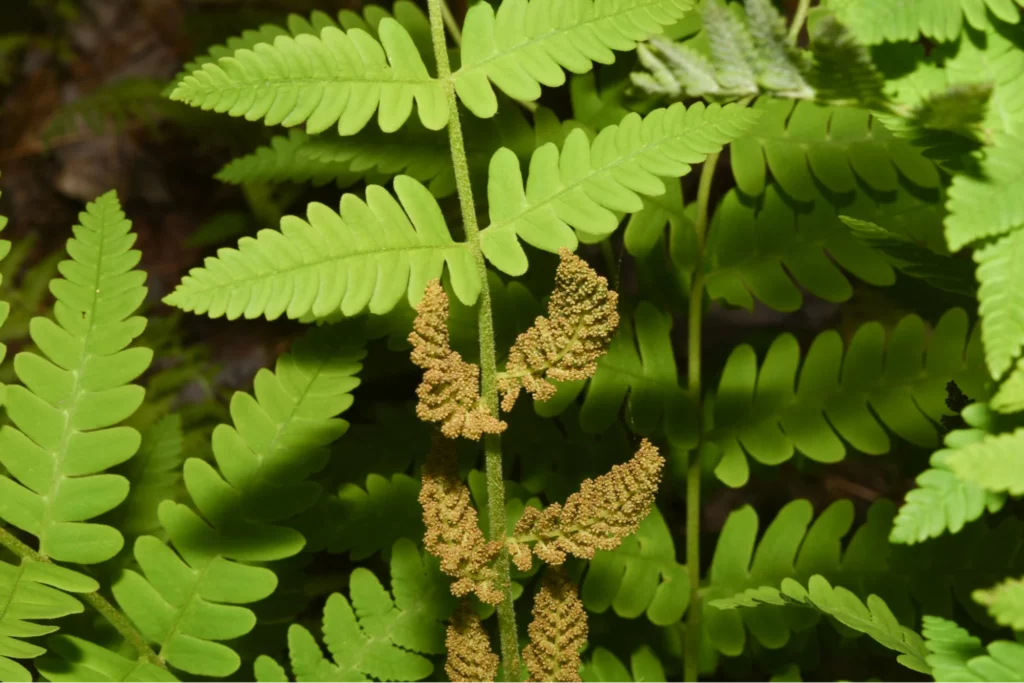
This is one of the easiest ferns to recognize once you know what to look for. It gets its name from the fertile leaflets that “interrupt” the center of the frond, brown and spore-covered, standing out from the green sterile parts above and below.
Habitat: Often found in woods, fields, and along roadsides. Tolerates sun or shade, and thrives in moist to moderately dry soil.
Field Marks:
- Grows in symmetrical clumps, reaching up to 30 inches
- Fronds are twice-cut and large
- Fertile leaflets appear only in the middle section of the frond
Diagnostic Tips:
- Vascular bundles in a U-shape (visible in cross-section)
- Lacks woolly tufts at the base of leaflets
- Sub-leaflets usually overlap
Cinnamon Fern (Osmundastrum cinnamomeum)
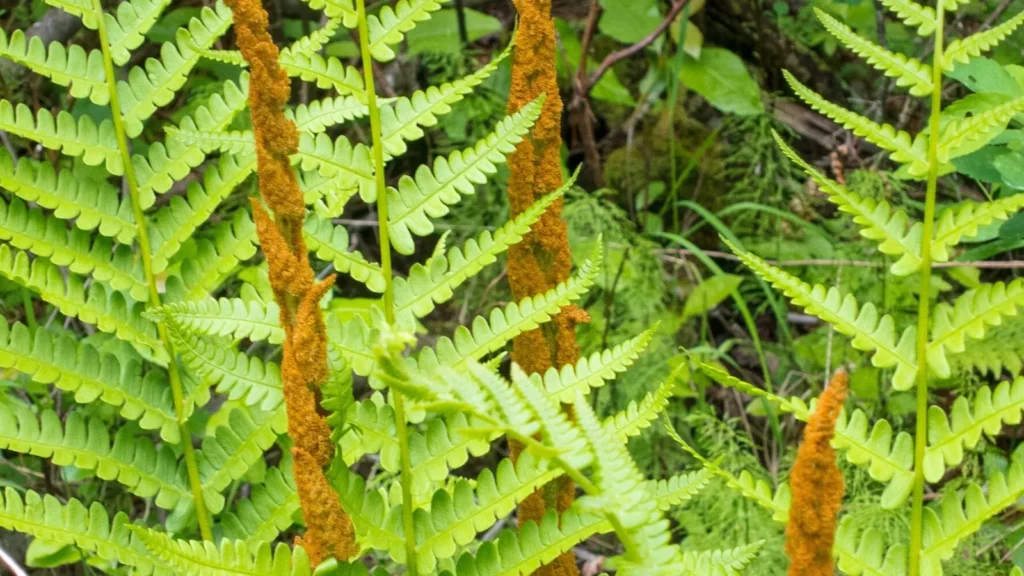
Known for its cinnamon-colored fertile fronds, this fern is both striking and widespread. The fertile fronds appear upright in the center, surrounded by sterile green fronds that can reach 30 inches or more.
Habitat: Prefers wet environments, such as swamps, ditches, bogs, and moist woodlands. Often found along roadsides. A strong wetland indicator species (FACW).
Field Marks:
- Symmetrical clump form
- Large, twice-divided fronds
- Central fertile fronds emerge with a cinnamon-brown color
Diagnostic Tips:
- Stipe (stalk) covered with cinnamon-colored hairs
- Woolly cinnamon tufts found at leaflet bases
- Sub-leaflets don’t overlap
- Leaflets have long, pointed tips
Sensitive Fern (Onoclea sensibilis)
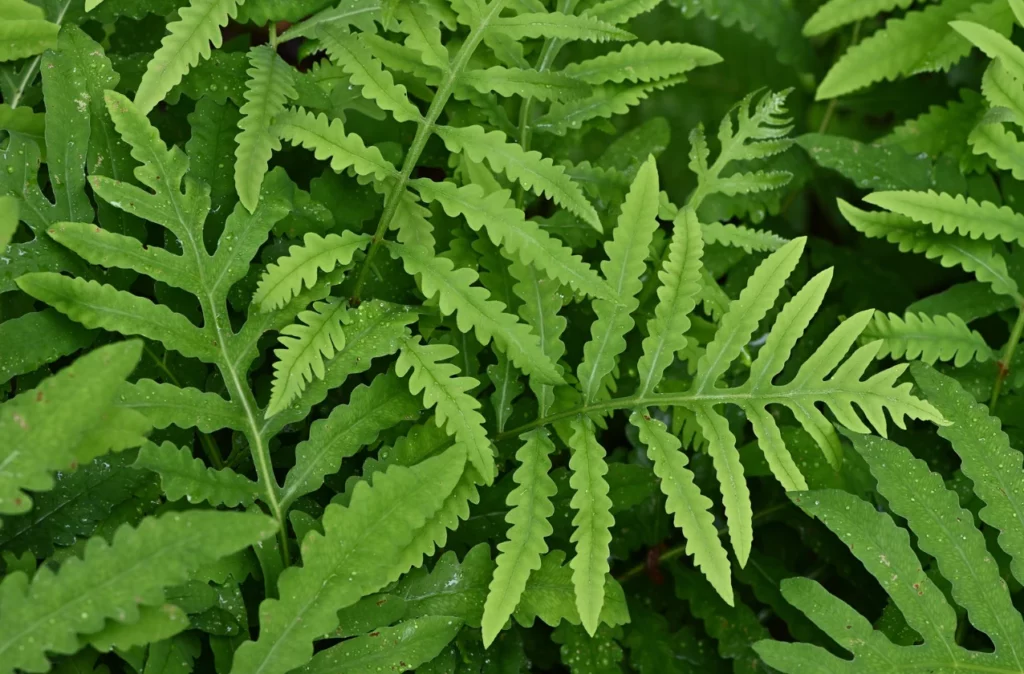
This fern is named for its quick reaction to frost. It withers at the first cold snap. It’s commonly found in wet areas and is one of the most distinctive native species.
Habitat: Swamps, marshes, roadside ditches, and wet meadows. Grows well in both sun and shade. Another wetland indicator (FACW).
Field Marks:
- Grows in loose clusters rather than tight clumps
- Fronds are once-divided with broad, wavy edges
- Fertile fronds look like stiff, bead-like spikes and can persist into winter
Diagnostic Tips:
- Yellow-green leaf color
- Net-like vein pattern
- Lower pinnae are widely spaced
- Stems are smooth, stiff, and often brittle
- Upper pinnae have narrow wings along the rachis
Marginal Wood Fern (Dryopteris marginalis)
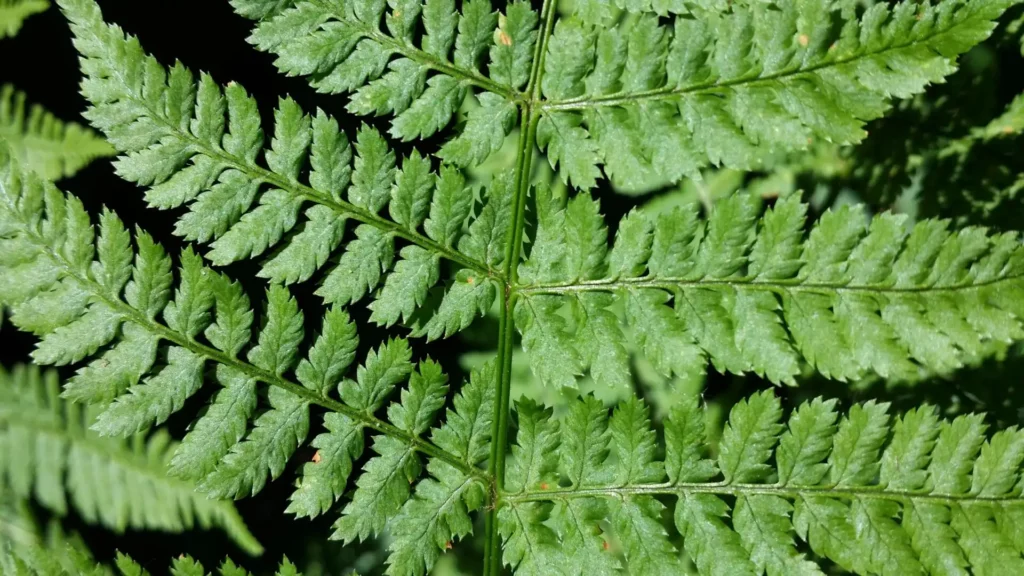
A rugged, evergreen fern often seen growing out of rock walls or forest boulders. The name comes from the sori placement—right at the leaflet margins.
Habitat: Common in woods, roadsides, and rocky slopes. Prefers moderate moisture and shaded conditions.
Field Marks:
- Forms a tidy, symmetrical clump
- Fronds are dark green, leathery, and twice-cut
- Fertile and sterile fronds look the same
Diagnostic Tips:
- Very scaly base and stipe
- Fruit dots (sori) are marginal
- Evergreen and slow to decompose
- Vascular bundles are round and multiple
Christmas Fern (Polystichum acrostichoides)
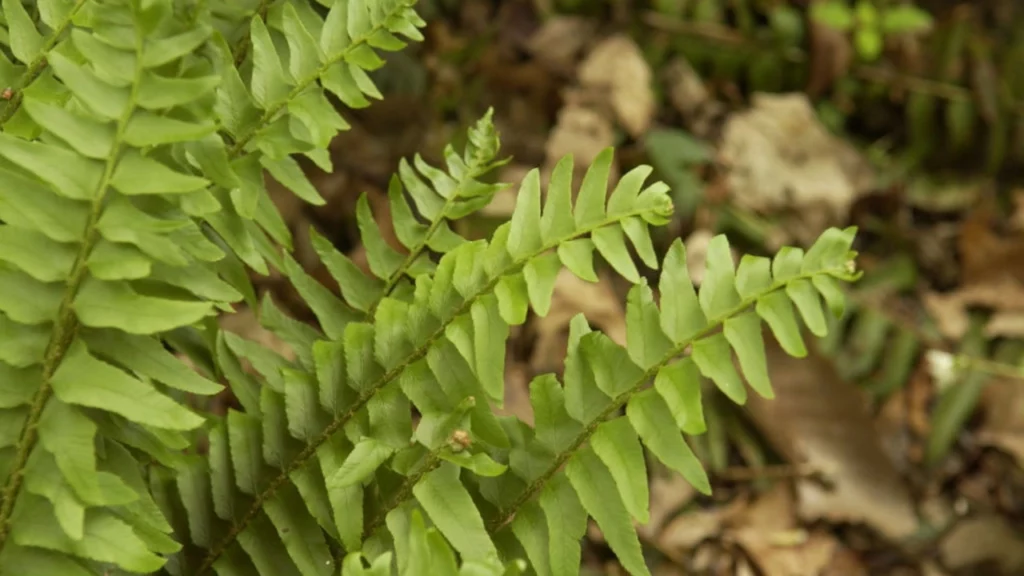
This fern stays green through the winter, which is part of how it earned its name. Its fronds grow in tight clumps and are easy to spot in shady slopes and woodland paths.
Habitat: Very adaptable. Found in woods, roadsides, rocky slopes, and disturbed areas. Prefers semi-shade and moderately moist soil.
Field Marks:
- Fronds are once-divided and are around 12 inches or longer
- Leaflets are eared, toothed, and often twisted
- Fertile fronds narrow at the tip
Diagnostic Tips:
- Light brown scales cover the stipe
- Fiddleheads are silvery and coil like a nautilus shell
- Evergreen year-round
New York Fern (Parathelypteris noveboracensis)
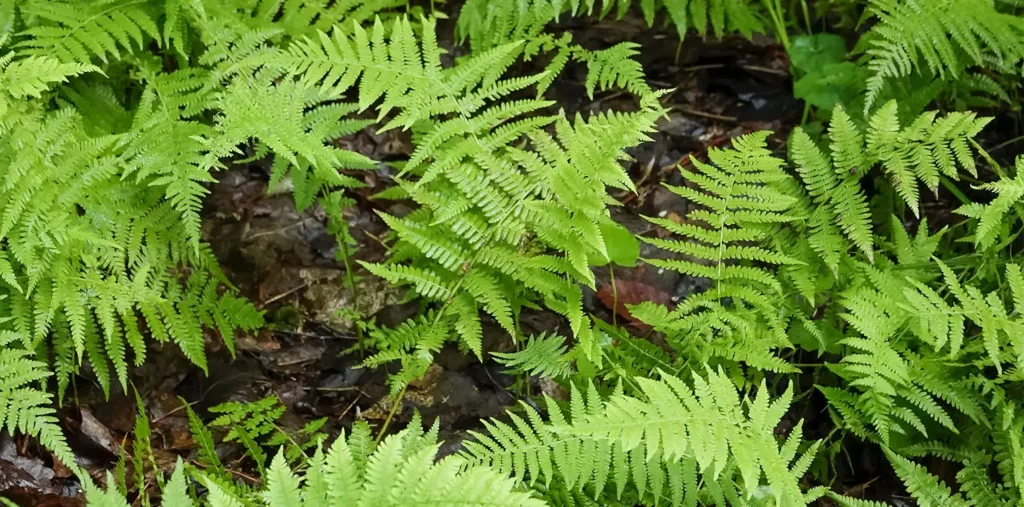
You can recognize this delicate fern by its shape: narrow at both the base and the tip, like a candle flame. It tends to grow in colonies.
Habitat: Open woods, roadsides, and mid-slope forest areas. Prefers dappled light or partial sun.
Field Marks:
- Fronds are twice-divided, thin, and 8–20 inches long
- Tapers clearly at both ends
- Usually grows in dense patches of 3+ stems
Diagnostic Tips:
- Stems slightly hairy above and bare below
- Sori are round with a kidney-shaped covering (indusium)
- Fertile fronds stand more erect and are narrower
Fern Identification Guide: Field Tips for Beginners
1. Take clear photos of both the top and underside of the frond. Include close-ups of the sori (spore dots) and the overall shape of the plant.
2. Check the environment. Soil moisture, shade, and elevation often indicate the right species.
3. Carry a notebook, or use an app like Planteyes to log what you find. Add photos, habitat notes, and your best guess. Over time, your ID skills will sharpen naturally.
4. Avoid touching unknown ferns with your bare hands. While most are harmless, a few may irritate your skin or grow near toxic lookalikes.
Conclusion
In conclusion, ferns may seem quiet and unassuming, but once you learn to identify them, they reveal a whole new layer of the natural world. Try the Planteyes app to identify ferns quickly, compare species side by side, and build your visual log, all from your phone.
FAQs
Do ferns grow in sunny places, or just in shade?
Most ferns prefer shade or partial light, but some species, like New York fern or hay-scented fern, can handle more sun, especially in moist environments.
Are all fiddleheads safe to eat?
No. Only fiddleheads from specific species, like ostrich fern, are considered edible. Others may be toxic or cause stomach irritation if eaten raw.
What’s the easiest fern to identify for beginners?
Christmas fern is a great starting point. Its leaflets look like little stockings, and it stays green all year, making it easy to spot even in winter.
Is using a plant ID app better than a field guide?
Both have their strengths. Apps like Planteyes are faster and great for beginners, while field guides offer deeper context. Using both together gives you the best results.


